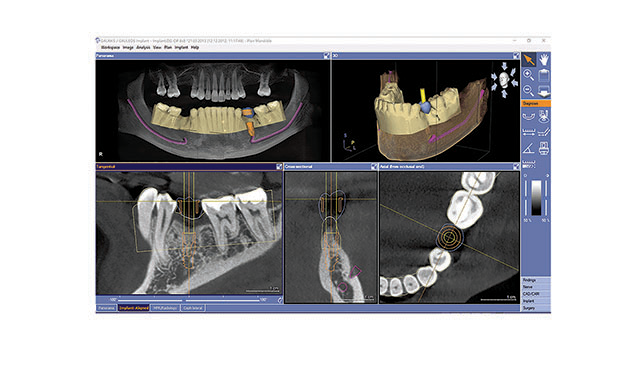A complete approach to implant planning
How SICAT Implant/Galileos Implant planning software has simplified implant treatment for one clinician.

Dr. Richard Anderson

Implants can be difficult, even for specialists. So, when Dr. Richard Anderson, a general dentist at Empower Digital Dental in Cloverdale, Calif., wanted to integrate implant planning and placement into his practice offerings, he knew he needed to adopt technology that would allow him to do it safely and effectively.
“I was trained well in placing implants after my Air Force residency, but the amount of planning was extensive and cumbersome,” Dr. Anderson explains. “In the end, you were really taking an educated guess on what you were doing, with much risk to the patient, both functionally and esthetically. In the beginning, I had many implant placement outcomes that were less than desirable.”
This changed when he began using SICAT Implant/Galileos Implant planning software in his practice in 2011.
“I was so happy to finally have a solution to my challenges of implant placement,” Dr. Anderson says. “I just couldn’t believe that I could plan an implant surgery with such accuracy and know that the outcome could be so predictable.
“The SICAT software takes a very complex surgical procedure, that can present many pitfalls and challenges to a general dental practitioner, and make it a quick, safe and predictable everyday procedure. It has taken the anxiety and guesswork out of a high-end surgical procedure and made it simple for me as a general dentist.”
Since SICAT offers a complete implant workflow-from 3D diagnostics and digital planning to surgical-guide creation-Dr. Anderson found that the software simplified every step of the process.
“I really feel like SICAT Implant/Galileos Implant planning software is the simplest implant planning software in the world. Its absolute ease of use is unparalleled.”
Dr. Anderson says the software offered him all the tools he needed for implant planning, including an implant-aligned workspace for easy planning and alignment of implants and other sleeves and abutments. Additionally, the workspace’s intuitive toolbar makes nerve mapping, measuring, implantation planning and viewing an easy task.
“I also find that the extended views available in this software (panorama, implant-aligned, and MPR/radiology) are unprecedented,” Dr. Anderson adds. “3D viewing can be a difficult challenge for new users, but the SICAT software makes orienting in the three planes a simple task.”
The SICAT surgical guides have also been invaluable to Dr. Anderson. “I absolutely love the surgical guide options and wouldn’t even consider placing an implant unguided anymore. The variety of production options makes it convenient for any practice: You can mill your own guide on the CEREC machine, send the information to SICAT to have them fabricate the guide, or SICAT can send the STL guide to the lab of your choice for printing.”
And the software’s benefits aren’t limited to its own system.
“The best surprise is that SICAT has made Galileos open,” says Dr. Anderson. “Any DICOM file can be imported into it. All the excellent benefits of this software can be used virtually with any cone beam file taken on any brand of machine. This is very helpful to me, as I work with many different offices that have different CBCT machines made by different companies.”
While it does take some training to fully integrate the software into an implant workflow (understanding the intricacies of the guided implant surgical kit and how it integrates with the software is critical, Dr. Anderson says), once practitioners learn the software’s capabilities, the benefits for implant planning and production processes are unrivaled.
